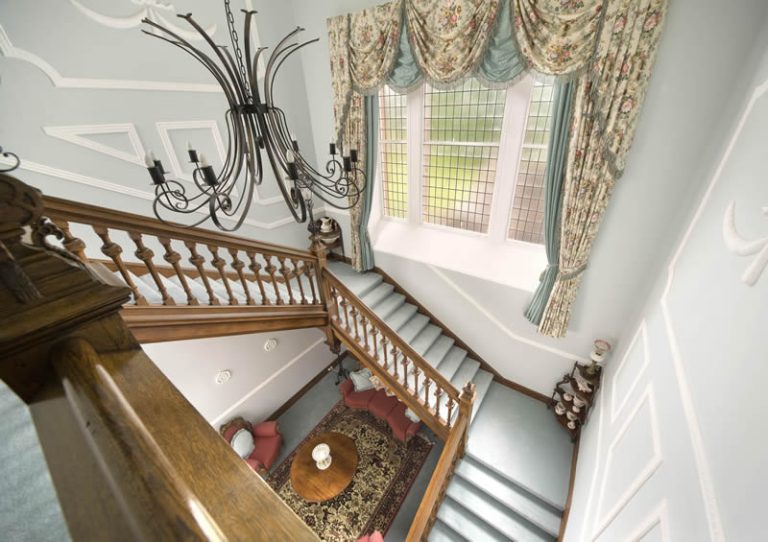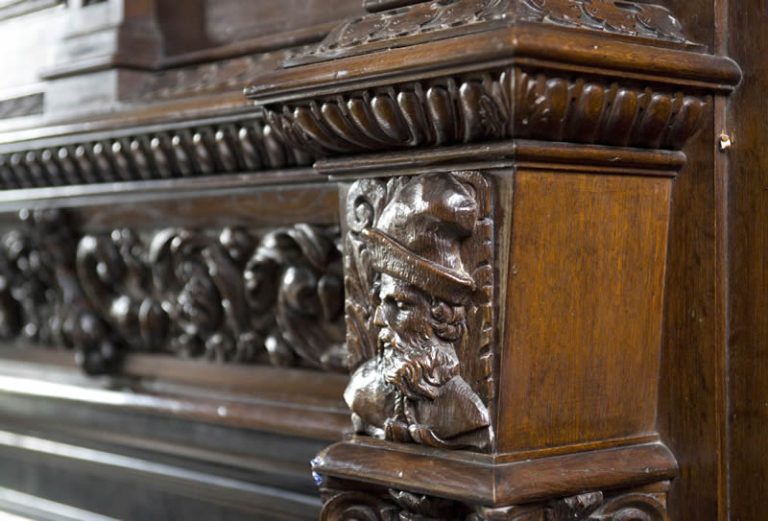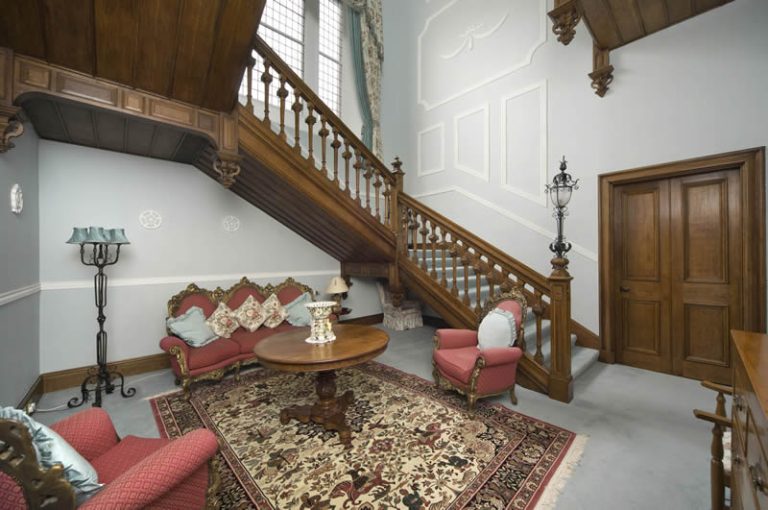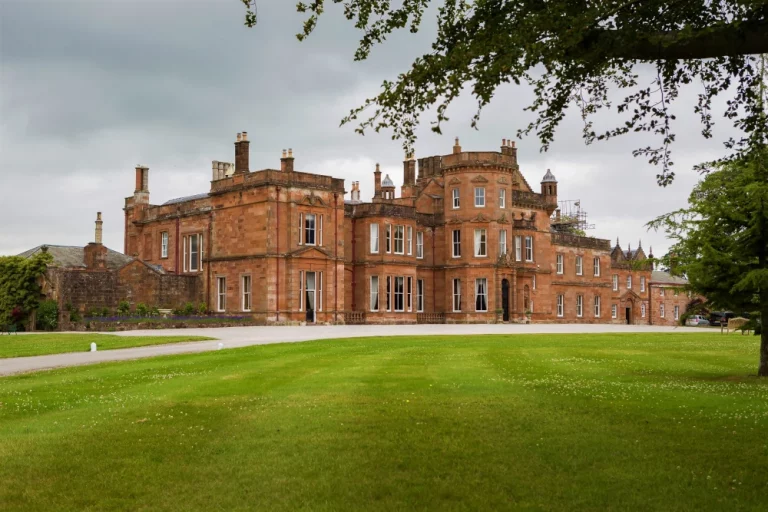

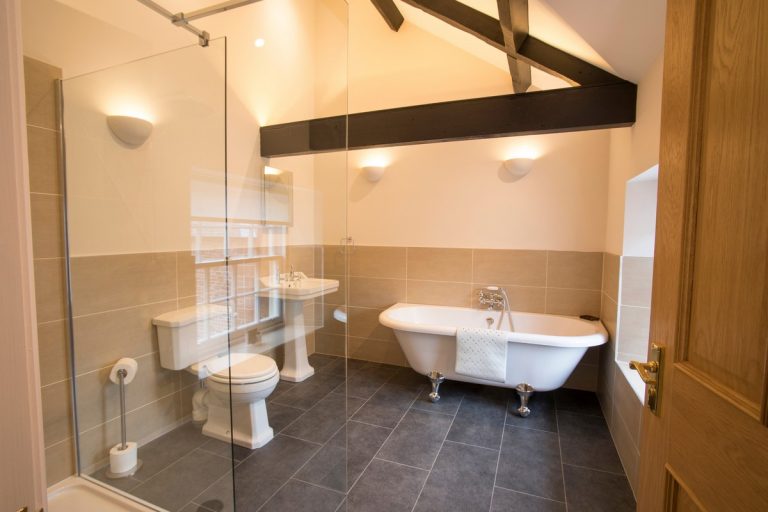
A History of Netherby Hall
If settlements could talk, Netherby Hall would have a fascinating story to tell.
Records show that Netherby Hall has been occupied for at least 2,000 years.
By AD80 the Romans were probably using the site as a base but it was not uncommon for the forces of the greatest empire in the world at the time, to take over places long used by local people.
With it’s pleasant site above the River Esk and flat lands that could have been cleared of trees for agriculture, it’s quite possible, perhaps even probable, Netherby Hall sits on ground that had been settled perhaps hundreds of years before Julius Caeser cast his eyes on our “tin islands”.
Earliest Inhabitants
In 2017, while carrying out an investigation of the area to the south of the Walled Garden, archaeologist Gerry Martin uncovered a large manmade ditch well below ground level. There were no objects that could be used to date it but, from the absence of Roman remains that have been found in abundance across the site, Gerry concluded that it was most probably dug much earlier than the period of the Roman occupation.
To find out how old the ditch was Gerry took samples of the material and sent them to Oxford University for dating using a technique called Optically Stimulated Luminesce, or OSL for short. This enables scientists to say when a mineral such as sand was last exposed to sunlight. When the OSL report came back it contained a central estimate of 693 BC with a range of plus or minus 230 years either side of this date. So, what we can say with a high degree of confidence is that the ditch was filled in between 923 BC and 463 BC, most likely around 690 BC.
It is not possible to tell whether the ditch was filled in by natural processes or human action, but it does not appear to be a natural feature and so it must have been dug out involving a considerable amount of hard work some time in either the later part of the Bronze Age or the early Iron Age. The amount of effort that would have gone into digging it suggests that Netherby was a site of some importance to the diggers.
While we talk about the Stone Age, the Bronze Age and the Iron Age, the transition from one technology for the manufacture of tools, weapons and various other types of objects did not happen at the same time in different places. What the archaeological record shows us is that it happened at different times in different places as new techniques spread outwards from the places where they originated. The Bronze Age in Cumbria covered the period from approximately 2000 BC to 750 BC and was followed by the Iron Age, which is conventionally dated to end with the Roman invasion of 43 AD.
The discovery of the ditch also lends weight to the claim that a group of Bronze Age spearheads donated to Tullie House museum in Carlisle by Sir Fergus Graham of Netherby were, as they were reputed to be, found at Netherby. Owing to the similarity of the objects in terms of condition and patina experts have for a long time accepted that the group of five objects most likely formed a single hoard, but there has been some scepticism about the hoard having been discovered at Netherby rather than elsewhere and added to the Graham family collection. The dating of the ditch shows that Netherby was a place of significance during the Bronze Age and makes it more plausible that the hoard of spearheads was buried there.
During the Bronze Age there was a transition from one type of bronze containing only copper and tin to one with the addition of lead. This happened in the South of England about two hundred years before it supplanted the earlier method in the North, where the old ways continued down to the eighth century BC (800 BC to 701 BC). The Netherby spearheads belong to the older metalworking tradition*. The dating of the ditch and the age of these spearheads is intriguing as the hoard could have been buried at the time the ditch was filled in.
* Source: Colin Burgess, Bronze Age Metalwork in Northern England, Oriel Press, 1968.
Netherby Hall's Roman Era

They named it Castra Exploratorum, the Fort of the Scouts to you and I. Netherby Hall’s living quarters and gardens now sit astride what, at its height, was a major military outpost for the Romans secure behind the massive wall built by the Emperor Hadrian.
For almost 300 years it’s likely the Fort played a major role in keeping the northern tribes at bay.
According to the scant records of the time the site was used by Hadrian for his military campaigns from 80AD but the Fort itself appears to have been built at the same time as the Wall which was started in AD122.
From inscriptions historians have deduced that Castra Exploratorium was made up of at least two, possibly four, encampments with the first recorded garrison, in about AD125, being some 500 foot soldiers of the Cohors I Nervanorum. Later it was base to the 1,000 men and 300 horses of the Chohors I Hispanorum.
Much more information came to light in 1732 when workmen, digging for dressed stones, came across a building which turned out to be the remains of an elaborate bathhouse between the fort and the river Esk.
The bathhouse turned out to be identical in all details to three others found later on the wall at Benwell, Carrawburgh and Chesters, leading experts to believe they were probably designed and built by the same person.
When the bathhouse was uncovered, an inscribed altar was discovered in one room and a further 18 inscriptions also came to light.
One, a single tombstone, was of great interest. It was that of a woman, named Titullinia Pussitta, who was possibly the wife of one of the unit commanders stationed at the fort and the only woman (apart from domestic slaves in her house) likely to be found in the military camp.
However, there is also written evidence that a much larger settlement had built up around the Fort.
It is said Rome was not built in a day. It certainly did not decay in a day either. After the Romans quit their “tin islands” circa 410 their settlement at Netherby was taken over by local chieftains but almost inevitably fell into decay. However, its ruins were still very visible more than one thousand years later.
John Leland, who visited the site in 1539, wrote: “ There have been many marvelous buildings here as can be seen from the ruined walls. Men alive have seen rings and staples on walls as they had been for ships. On the one side of it there is the debatable ground and so it is both English and Scottish. The ruins are now about three miles from the flowing water of the Solway. Grass now grows on the ruins of the walls.”
Around the same time other reports talk of the outline of streets running from the fort down to the river being clearly visible.
In 1601, Reginald Bainbrigg, schoolmaster of Appleby, copied a Roman inscription on a stone that was part of the front of the house, during a visit.
He also wrote “Ships’ sides, anchors and iron rings such as ships are tied up to” had been found suggesting the place had been a port at one time but an “accumulation of sand” had cut it off from the Solway.
Seventy years later Sir Daniel Fleming described “prodigious heaps of (Roman) ruins” at the site and that was the last mention of them until the bathhouse find which indicates they were probably cleared away perhaps for new building projects.
For more information about the Roman History of Netherby Hall, please free free to click the button below to download an in-depth PDF:
After the Roman Occupation

When the legions left for good in AD410, the Romano Britons were essentially left to get on with life as best they could without the protection of the might of the Mediterranean empire.
The fort at Netherby Hall was occupied by various chieftains over the coming years and may have been visited by the individual, or at least the character who inspired him, who was to become a household name today, King Arthur.
A growing number of people are challenging the Arthurian tales as written down by Geoffrey of Monmouth, on commission for English nobility, who placed all the action in the south west of England.
The original tales come from the old Welsh annals. At the time of writing the Welsh kingdom was not where Wales is today. It stretched from southern Cumbria to the River Clyde and Dumbarton Rock.
Several books have now been written suggesting Arthur was a Romano British chieftain and placing his battles around the Border. Netherby Hall of course is in Arthuret parish, the name suggesting it had associations with Arthur.
So perhaps it is possible that the man of legends once walked the ground where the house and gardens now stand.
Little exists in the records of this part of Cumbria for several hundred years but by the 1400s Netherby had taken the form of a solid Border peel tower, probably built from the ruins of the old Roman Fort.
And that is understandable given the estate lies alongside the Debateable Lands, an area roughly ten miles long by six wide stretching inland from the Solway which belonged to neither Scotland nor England. It was a hotbed for the roughest of Border Reivers for many, many decades.
Netherby would undoubtedly have fallen victim to Reiver Raids from both sides of the Border.
But by the late 1500s Netherby was owned by the Graham family, in a partnership that was to last for some 400 years. And during that time the house and estate prospered.
The first development of the house and gardens probably did not take place until the early 1600s. It was only then that the life of the Reivers was brought to a pretty abrupt end by King James VI when he ascended the English throne.
Certainly Nikolaus Pevsner in his book “Buildings of England Cumberland and Westmorland” published in 1967, identified 17th century paneling in the hall and dining room containing “many small religious scenes” along with barley sugar columns said to have come from a Belgian abbey.
The Graham family were responsible for extensive development of the house and gardens.
Pevsner noted that Dr Robert Graham came into possession in 1757 and from his time there was one room with an “excellent plaster ceiling”, one rounded room with two niches and one room with wall plasters.
The other rooms were mostly Victorian, especially the magnificent staircase.
He described the house as mainly “baronial with some Jacobean touches and the last thing one would expect is the real peel tower hiding behind a seemingly Victorian tower with its comical knight in a niche”.
He dated many of the features, including three magnificent bay windows, from the mid 18th century with the facade from one hundred years later.
The Graham Family Estate

For four centuries the Graham family nurtured and developed Netherby and its estates before they finally parted company in the late 1900s.
There’s is a tale of “rogues to riches”, steeped in the history of the Borders with its notorious Reivers and a unique part of the country that went by the forbidding name of the Debateable Land.
It appears the Netherby Grahams descended from nobility, through Lang Will Graham, born in 1468, a grandson of Malise, Earl of Strathearn and 1st Earl of Menteith.
Sometime before 1492, the King of Scots, probably James III, got fed up of Lang Will’s business practices. He was well known for his Reiver ways of extracting rents, mails, for land he did own but he went too far when he stole lands from the Earl of Morton.
Put to the horn, in other words and outlaw, he was eventually forced to flee with his family to the Debateable Land, an area between Langholm and the Solway claimed by neither Scotland nor England. It was a British badlands, an area where any person who was outwith the law and consequently could be killed without any redress on the killer, would find refuge. As such it was home to some of the most notorious Border Reivers, the Grahams among them.
Lang Will’s family prospered. By the 1540s, made up of at least six sons, they had half a dozen peel towers and the eldest son, Richard, owned Netherby. Lang Will’s rent collecting business, blackmail to you and I, raised vast amounts of money, 100,000 merks according to one source. They were allies of the Armstrongs and linked by marriage to the Johnstones.
But they were arrogantly confident about their strength and abilities as a record from the State Papers of Henry VIII, in the shape of a letter from his nephew, King James V, reveals. It complains that on May 29, 1541, six sons of Lang Will Graham (Richard, Thomas, Fergus, Will, John, and Hutchin), along with about 50 others, on an open day foray came to Auchinbadrig, in the lands of Logane, in the parish of Kirkpatrick (Dumfriesshire) and there murdered brothers Thomas, Rolland, and William Armstrong, sons of David Armstrong. The accused then brazenly appeared the following Tuesday at a day of truce held by the Scottish West March Warden, Lord Maxwell, and his English counterpart, Sir Thomas Wharton, with the blood of the slain still on their hands, faces, and clothes. Maxwell was rebuffed when he asked for redress.
It was not the last time the Grahams would be part of a rebuff to the Maxwells. They fought alongside the Johnstones at the Battle of Dryfe Sands in December, 1593. The vastly outnumbered Johnstones out thought and outfought Lord Maxwell’s superior forces in a running battle through the streets of Lockerbie.
King James VI brought the reiving way of life to an end after he ascended the English throne in 1603. But the Graham’s success story continued with another Richard, almost certainly a grandson of Lang Will. Born in 1583, he was a favourite of King James and became Master of the Horse to the Duke of Buckingham, entrusted to run errands all over Europe. One was to arrange the marriage of the King of Spain’s daughter to King Charles 1.
He is referred to as Sir Richard and is credited with taking the first steps to turn the old peel tower into the magnificent home and gardens it was to become.
So in the space of three generations the fortunes of the Graham family had been transformed from notorious outlaw to a Royal favourite at the heart of the kingdom.
The work on the Hall was to continue through successive generations. Alterations made by Dr Robert Graham, who took possession in 1757, were still visible in the 1960s.
Possibly Netherby’s most celebrated son was Sir James Graham, 1792 -1861, who became MP for Carlisle and several other constituencies, and has been described as a politician of national importance, a British statesman.
The second baronet, in an illustrious career he was First Lord of the Admiralty and went on to become Secretary to the Home Department under prime minister Robert Peel. Graham Land in Antarctica is named after him.
He carried out further extensions to the house in 1833.
His father, the first baronet, also James, was a friend of the great Scottish author, Sir Walter Scott, who, it is claimed, wrote his famous poem, Young Lochinvar, at Netherby in 1802.
Much of the estate was sold off in the early twentieth century but it remained in the family’s hands until the 1990's.
Robbery at Netherby Hall

Netherby Hall may well have been plundered time and time again during the years of the Border Reivers but, nearing the end of the 19th century, it no doubt seemed all that was behind the place.
Lady Graham probably never expected her home was to become the scene of probably the most infamous robbery ever in Cumbria.
It happened on the evening of October 28, 1885. While the Grahams were dining a London based gang climbed into the house using a ladder and escaped with prized jewellery.
The four gang members were Anthony Benjamin Rudge, John Martin, James Baker and William Baker. They were an entirely ruthless bunch, armed with different weapons, including revolvers, which they were to use.
Rudge was a suspect in a robbery in Brixton, south London; Martin was wanted for the murder of a police inspector in Essex; and police suspected William Baker had been involved in a Newcastle jewel theft a number of years earlier.
They had made their way north by train arranging to join up at a coursing meeting at Longtown on October 27.
The alarm was raised by a maid at 8.15 the following evening but by then, the gang had disappeared.
However, they were spotted at Kingstown in Carlisle by two local policemen, sergeant Roche and Constable Johnson who bravely tackled the men. Both officers were initially beaten with an iron bar and then, as they pursued the fleeing gang, the sergeant was shot in the arm and the constable in the chest.
The robbers made it to the Dalton Road crossing of the North Eastern Railway where they were intercepted by Constable Fortune who was immediately beaten unconscious by the jemmy.
The men were next spotted at Plumpton, by the stationmaster, who told PC Byrnes and that’s when the chase took and extreme turn for the worse. By now police were aware the gang would stop at nothing to get away and as PC Byrnes was searching for them, he was shot in the head and thrown over a wall. The constable died.
The gang managed to scramble on to a goods train heading south but again were spotted, this time by a cool headed guard, Geddes, who did nothing to make them suspect they had been recognised. Geddes posted a message asking police to meet the train at Tebay and it was spotted by the driver of a passing engine.
Geddes then got a number of railwaymen together and, armed with shovels and sticks, they went for the gang at Tebay. Martin and Rudge were captured after a chase. They were found to be carrying revolvers. James Baker got away but was captured by a guard at Lancaster Station. William Baker was also on the run but was picked up in Manchester.
Rudge, Martin and James Baker were taken back to Carlisle for trial. An angry mob was waiting them and they were almost lynched. After a three day court case they were found guilty and all were hanged.
William Baker, who had not been present at the robbery, was jailed.
Lady Graham’s jewellery was recovered at Tebay.

